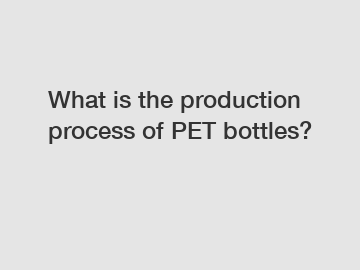What is the production process of PET bottles?
What is the production process of PET bottles?
PET bottles, also known as polyethylene terephthalate bottles, are one of the most commonly used types of bottles for packaging beverages, liquids, and other consumer products. The production process of PET bottles involves several steps, each contributing to the creation of a durable and reliable packaging solution. In this article, we will explore the different stages of the production process and gain a deeper understanding of how these bottles are manufactured.
1. Raw Material Preparation:

Before the production of PET bottles can begin, the raw material, which is PET resin, needs to be prepared. PET resin is a type of polyester that is derived from crude oil. It is a clear and strong plastic that is highly suitable for bottle production. The PET resin is melted and formed into small pellets or chips, which will be used as the feedstock in the subsequent steps.
2. Injection Molding:
Injection molding is the most common method used for producing PET bottles. It involves the use of a mold cavity, which is shaped like the desired bottle. The PET resin pellets are fed into a hopper, which then transfers the material to the injection molding machine. The resin is heated and injected under high pressure into the mold cavity, where it takes the shape of the bottle. Cooling is then applied to solidify the plastic, and the mold is opened to release the finished bottle.
3. Stretch Blow Molding:
After the injection molding process, the bottles created are known as preforms. Preforms are smaller versions of the final bottle, with thicker walls. These preforms are then reheated in a stretch blow molding machine. The machine uses both heat and air pressure to stretch and expand the preforms into the desired shape and size. This process ensures uniform thickness in the bottle walls and imparts strength and durability to the final product.
4. Bottle Finishing:
Once the bottles have been molded and blown, they go through a series of finishing steps. This includes trimming excess material from the bottle, such as the neck and base, to achieve the desired shape and size. The bottles are also subjected to quality checks and inspections to ensure they meet the required standards. Any defective bottles are removed from the production line to maintain the overall quality of the batch.
5. Labeling and Packaging:
After the bottles have been thoroughly inspected and checked for quality, they are ready for labeling and packaging. Labels are applied to the bottles using adhesive or heat-shrink methods, depending on the design requirements. Once the bottles are labeled, they are sorted, packed, and prepared for transportation. The packaging process may involve placing the bottles in cartons, plastic trays, or shrink-wrapped packages, depending on the customer's specifications.
In conclusion, the production process of PET bottles involves several stages, starting from the preparation of raw materials, to injection molding of preforms, stretch blow molding, bottle finishing, and finally, labeling and packaging. Each step is vital in ensuring the creation of high-quality, reliable, and safe PET bottles for various consumer applications.
If you have any further questions or would like to discuss PET bottle production in more detail, please feel free to contact us. Our team of experts is available to provide you with the necessary information and support.
For more rPET pellets, rPET pellets, rPET pelletsinformation, please contact us. We will provide professional answers.


